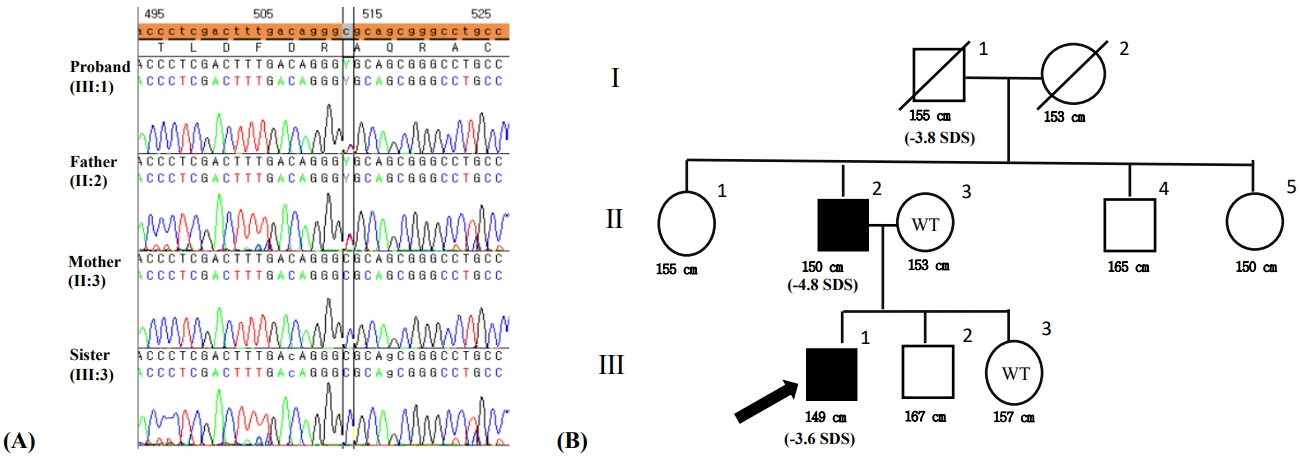Ann Pediatr Endocrinol Metab.
2020 Dec;25(4):272-276. 10.6065/apem.1938198.099.
Identification of a heterozygous ACAN mutation in a 15-year-old boy with short stature who presented with advanced bone age: a case report and review of the literature
- Affiliations
-
- 1Department of Pediatrics, Yeungnam University Hospital, Yeungnam University College of Medicine, Daegu, Korea
- 2Rare Genetic Disease Research Center, 3Billion Inc, Seoul, Korea
- 3Department of Laboratory Medicine, Inje University, Busan Paik Hospital, Inje University College of Medicine, Busan, Korea
- 4Department of Pediatrics, Inje University, Busan Paik Hospital, Inje University College of Medicine, Busan, Korea
- KMID: 2510899
- DOI: http://doi.org/10.6065/apem.1938198.099
Abstract
- Longitudinal bone growth is primarily mediated by the growth plate, which is a specialized cartilaginous structure. Aggrecan, encoded by ACAN, is a primary proteoglycan component of the extracellular matrix in both the growth plate and articular cartilage. Aggrecanopathies have emerged as a phenotype of genetic skeletal disease in humans. A heterozygous ACAN mutation causes short stature, premature growth cessation, and accelerated bone age maturation. We report the case of a 15-year-old boy with familial short stature, with height of 149 cm (Korean standard deviation score [SDS] of -3.6) and weight of 50.5 kg (-1.48 SDS). He presented with mild midfacial hypoplasia, frontal bossing, a broad chest, and a short neck. The father's and mother's heights were 150 cm (-4.8 SDS) and 153 cm (-1.69 SDS), respectively. The patient's bone age was 2–3 years more advanced than his chronological age, and no endocrine abnormalities were detected. Wholeexome sequencing followed by Sanger sequencing revealed a heterozygous ACAN mutation, c.512C>T (p.Ala171Val), in both the proband and his father. Short stature is generally associated with a delayed bone age, and this case suggests that ACAN mutations may be the most likely etiology among patients with short stature and an advanced bone age and should warrant early treatment.
Keyword
Figure
Reference
-
References
1. Savendahl L. Hormonal regulation of growth plate cartilage. Horm Res. 2005; 64(2 Suppl):94–7.
Article2. Baron J, Sävendahl L, De Luca F, Dauber A, Phillip M, Wit JM, et al. Short and tall stature: a new paradigm emerges. Nat Rev Endocrinol. 2015; 11:735–46.
Article3. Anderson IJ, Tsipouras P, Scher C, Ramesar RS, Martell RW, Beighton P. Spondyloepiphyseal dysplasia, mild autosomal dominant type is not due to primary defects of type II collagen. Am J Med Genet. 1990; 37:272–6.
Article4. Tompson SW, Merriman B, Funari VA, Fresquet M, Lachman RS, Rimoin DL, et al. A recessive skeletal dysplasia, SEMD aggrecan type, results from a missense mutation affecting the C-type lectin domain of aggrecan. Am J Hum Genet. 2009; 84:72–9.
Article5. Kim YM, Cheon CK, Lim HH, Yoo HW. Identification of a novel heterozygous mutation of ACAN in a Korean family with proportionate short stature. J Genet Med. 2018; 15:102–6.
Article6. Valhmu WB, Palmer GD, Rivers PA, Ebara S, Cheng JF, Fischer S, et al. Structure of the human aggrecan gene: exon-intron organization and association with the protein domains. Biochem J. 1995; 309:535–42.
Article7. Dateki S. ACAN mutations as a cause of familial short stature. Clin Pediatr Endocrinol. 2017; 26:119–25.
Article8. Roughley PJ, Mort JS. The role of aggrecan in normal and osteoarthritic cartilage. J Exp Orthop. 2014; 1:8.
Article9. Nilsson O, Guo MH, Dunbar N, Popovic J, Flynn D, Jacobsen C, et al. Short stature, accelerated bone maturation, and early growth cessation due to heterozygous aggrecan mutations. J Clin Endocrinol Metab. 2014; 99:1510–8.
Article10. Gkourogianni A, Andrew M, Tyzinski L, Crocker M, Douglas J, Dunbar N, et al. Clinical characterization of patients with autosomal dominant short stature due to aggrecan mutations. J Clin Endocrinol Metab. 2017; 102:460–9.
Article11. Domowicz MS, Cortes M, Henry JG, Schwartz NB. Aggrecan modulation of growth plate morphogenesis. Dev Biol. 2009; 329:242–57.
Article12. Lauing KL, Cortes M, Domowicz MS, Henry JG, Baria AT, Schwartz NB. Aggrecan is required for growth plate cytoarchitecture and differentiation. Dev Biol. 2014; 396:224–36.
Article13. Dateki S, Nakatomi A, Watanabe S, Shimizu H, Inoue Y, Baba H, et al. Identification of a novel heterozygous mutation of the Aggrecan gene in a family with idiopathic short stature and multiple intervertebral disc herniation. J Hum Genet. 2017; 62:717–21.
Article14. Watanabe H, Nakata K, Kimata K, Nakanishi I, Yamada Y. Dwarfism and age-associated spinal degeneration of heterozygote cmd mice defective in aggrecan. Proc Natl Acad Sci U S A. 1997; 94:6943–7.15. van der Steen M, Pfundt R, Maas S, Bakker-van Waarde WM, Odink RJ, Hokken-Koelega ACS. ACAN gene mutations in short children born SGA and response to growth hormone treatment. J Clin Endocrinol Metab. 2017; 102:1458–67.
Article16. Hattori A, Katoh-Fukui Y, Nakamura A, Matsubara K, Kamimaki T, Tanaka H, et al. Next generation sequencing-based mutation screening of 86 patients with idiopathic short stature. Endocr J. 2017; 64:947–54.
Article17. Hauer NN, Sticht H, Boppudi S, Buttner C, Kraus C, Trautmann U, et al. Genetic screening confirms heterozygous mutations in ACAN as a major cause of idiopathic short stature. Sci Rep. 2017; 7:12225.
Article18. Hu X, Gui B, Su J, Li H, Li N, Yu T, et al. Novel pathogenic ACAN variants in non-syndromic short stature patients. Clin Chim Acta. 2017; 469:126–9.
Article
- Full Text Links
- Actions
-
Cited
- CITED
-
- Close
- Share
- Similar articles
-
- Identification of a novel heterozygous mutation of ACAN in a Korean family with proportionate short stature
- Short stature with low serum alkaline phosphatase activity: a case report of hypophosphatasia
- Familial male-limited precocious puberty due to an activating mutation of the LHCGR: a case report and literature review
- A Case of Hypocortisolemia Presented by Short Stature
- A Case of Bartter Syndrome with Muscle Weakness and Short Stature




